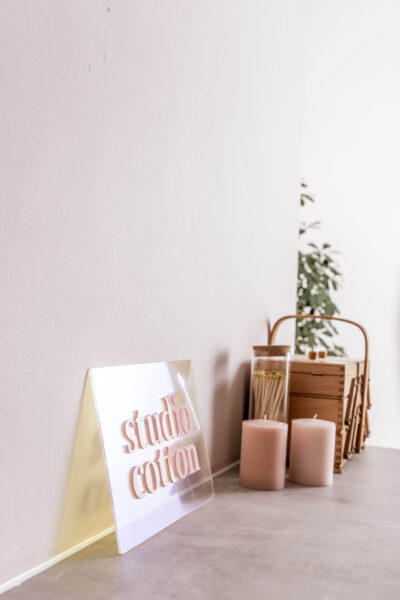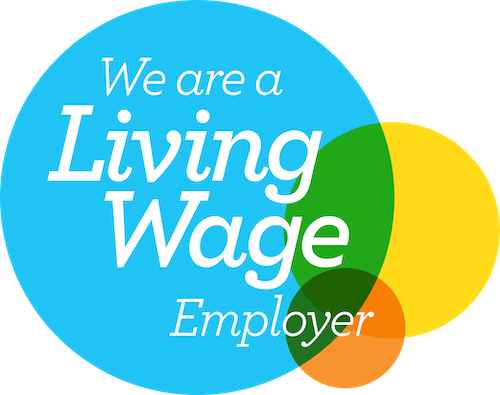Hey, I’m Aime and I run Studio Cotton. We work exclusively with independent brands and have been offering website design and one-to-one consulting services since 2016. I’ve made it a bit of a personal mission to help small businesses get way better websites, either by working with us on a new website build – or by providing advice, education, and actions for improving existing websites.
For six years, *pretty much* every single one of our clients and leads have arrived at our digital doors for a reason that could be sorted into one of two distinct buckets.
But over the past 18 months or so, we’ve needed a third bucket. A new reason why small business owners need some serious support with their website because it just isn’t producing the orders or enquiries they really, really need. And this new bucket seriously disheartens the heck out of me.
The non-negotiable ingredients of a successful small business website
I can’t really dive into reasons why small businesses are unhappy with the success of their current websites without first touching on what it actually means for a website to be ‘successful’. At this point, it might be worthing opening a new tab with my article, 6 non-negotiable elements of a successful small business website ya just need to know, but here’s the tl;dr:
- Aesthetics & design: The website needs to ‘look’ not only consistent with the small business’ brand identity, but it also needs to look professional. We never want a customer to think “hmmm, I’m not sure this is a legit business” when they land.
- Search engine optimisation (SEO): The practice of removing obstacles that ruin our Google rankings, whilst providing appropriate and well-structured info about what we sell so Google can rank us as high as possible for as many relevant searches and searchers as possible
- User Experience (UX): Humans are pretty predictable with how they interact with websites. UX is all about working with that behaviour to maximise the chances of our visitors converting into customers
- Accessibility: There are many disabilities that impact how our customers use websites; visual impairment, neurodiversities like dyslexia, and physical symptoms like tremors to name a few. Whilst it is unrealistic to have a ‘perfect’ website for everyone, it is our ethical and legal duty to remove reasonable barriers and abstain from introducing barriers that would disadvantage disabled visitors. Plus it’s just bad for business.
- Security: You gotta protect your business and your customer data
- Legal compliance: A website shouldn’t endanger a small business
It’s been a few months now since I published that article, but I’d like to add one more item that’s become particularly pertinent with the rising popularity of my disheartening third bucket, and differentiating them from our second bucket: the suitability of the website for the specific business case.
Ok, I need to think of a snappier title. A small business website needs to be suitable for the individual circumstances of that small business, for example:
- If a business has lots of seasonal offers, they need to be able to amend the home page regularly
- If a business is run by one person, it needs to minimise the management time
- If the business has a small budget, it can’t use tonnes of premium plugins with monthly licenses
- If the business wants to work on their SEO, it usually needs a blog that’s easy to update
- If the business can only ship £3,000 of products per month, it needs a website that reflects that maximum ROI
And now let’s dive into our buckets of small business website design clients.

Bucket One: Small businesses that have reached the limits of their DIY website
Most website design and website design clients arrive at Studio Cotton because they’ve gotten as far as their DIY website can take them. They might have reached the limits of their current skill set, or the technical capabilities of their platform, or their own patience and passion for website design and management.
Platforms like Squarespace and Shopify make it super easy for most people to create their own website but as their small business and/or their ambitions grow, they’ll often look to a professional website designer or website consultant to reach that new level.
Sometimes that means outsourcing a brand new website design and build, and sometimes that means getting the advice and action-packed to-do list that’ll massively upgrade their existing website.
Bucket Two: Small businesses that went too big, too soon
Before Studio Cotton I worked for a few different marketing agencies of a few different sizes (if you fancy knowing more, check out this Instagram post with my founder story), most of which offered website design services.
These agencies were usually pretty solid at designing good-looking websites that often provided a solid base for UX, SEO, accessibility, security and legal compliance. They wouldn’t often be totally bangin’, but they’d have good bones that allowed a small business to grow those qualities of a successful website. If they spent the time and, more often, the money.
And now the clients of these kinda agencies are in the second bucket here at Studio Cotton.
In practice, it often turns out that these good-bones websites weren’t that suitable for the individual small businesses. I’ve worked with small business owners who couldn’t add their own products to their websites. Who couldn’t integrate with Facebook and Pinterest shopping. Who couldn’t style their blog posts with basic features like headings. Who couldn’t update their own Google Analytics tracking tag. Who didn’t know what to next do with those good bones.
To make these changes they’d need to book additional projects that needed more investment, or sign on to mysterious retainers where they weren’t sure what they were getting. This way of operating a website design company isn’t unusual – as I said, I worked for many companies who did the same.
But if small business owners aren’t aware that a successfull website requires continual investment and financial commitment, it will often still leave them with a website that is not fit for their business needs.
Bucket three: Small businesses that invested in a website from someone who didn’t know what they didn’t know
I run a service-based business and I am CONSTANTLY barraged with targeted ads, usually on Instagram, on how to exploit small business owners. Yep. How I can exploit you.
I get relentless advertisements telling me I can get non-stop 10k months, 4x my income, earn money in my sleep and work just 6 hours a week from a tuktuk by doing this ONE thing.
And that ONE thing relies on small business owners being inexperienced, too trusting, and just straight-up manipulated by sales tactics that have been honed over decades.
That’s because these schemes are not new, and generally do the rounds through different industries. They’re the backbone of pyramid schemes that present themselves as multi-level marketing opportunities, and they’ve been rife in the world of coaching for far too long.
Since the pandemic they’ve also done the rounds in the worlds of copywriting, social media management, photography, and even knitting. And now they’ve hit the world small business website design.
Graphic and brand designers are barraged with the exact same ads I’m seeing, and they’re investing in the courses and the programmes that teach them how to increase their design studio’s revenue by selling website design services.
What these courses and programmes don’t teach them? SEO. UX. Accessibility. How to build a website that’s suitable for an individual business owner.
Ok, I can forgive security (as that’s largely good password management) and legal stuff because, well, they’re not lawyers and that’s always iffy territory.
What makes it worse is that these Brand New Website Designers – as I’m going to call them in this article – usually don’t know that they don’t know about SEO, UX and accessibility. They though can build some Bloody Beautiful Websites (another term I’m temporarily coining) and really nail that aesthetic and design element.
That’s when the clients of these Brand New Website Designers get in touch with Studio Cotton. Usually it’s to book a consultation or drop in to a free event because their Bloody Beautiful Website isn’t getting much traffic or converting into enquiries, and they want to know the secrets to SEO because it’s just that little sprinkle that’s missing, right?!?!
Thoughtfully crafted websites for lovely small businesses
Utterly splendid websites designed & built exclusively for small businesses (with all the bells and even more whistles).

The downsides of Bloody Beautiful Websites
In comes the disheartening moment, because I have lost count of how many Bloody Beautiful Websites are, at a technical and business-tool level, complete and utter turds. Here’s a list of some of the things I’ve encountered:
- Minimal text, which is bad for SEO
- No way to add more text or amend text, which is bad for SEO
- Super short pages and descriptions, which is bad for SEO
- Neglected pages, usually the about and contact pages, which is bad for SEO and UX
- Plethora of dead links, which are bad for SEO
- So. Many. PNGs. Photos in creative frames with transparent backgrounds, which load slowly and are bad for SEO
- Pages chocka with non-optimised images, which is bad for SEO
- Whole pages with creative titles that are all about creating a vibe, which is bad for SEO and UX
- Unclear options in the primary menu, which is bad for UX
- Too many options in the menu, which is also bad for UX
- Weird hidden menus, which are bad for UX
- Splash pages?!?!? These have been out of fashion for over a decade because they are bad for UX and horrendous for SEO
- Inappropriate use of semantic markup, usually heading tags, which is bad for SEO and accessibility
- Essential text contained within images, which is bad for SEO and accessibility
- Text that is just too dang small, which is bad for UX and accessibility
- Content that fails to actually describe what a business sells, which is bad for UX and accessibility
- Content hidden under hover effects or animations, which is bad for UX and accessibility
- Poorly executed custom code which makes updates and additions time consuming or impossible, which is bad for suitability and often SEO
- Systems bodged together when it’s clear the platform chosen wasn’t the best suited for the business, which is bad for suitability and usually UX
- Complicated methods for getting round these bodged systems increasing the time requirement and chances of something going wrong, which is bad for suitability
- And mmmmaaaaaaannnnyyyy more
Now that list isn’t exhaustive, and it’s also not designed to, well, shit on Brand New Website Designers. It’s also not meant to imply that every website that doesn’t have baller SEO, UX and accessibility is a bad website. That’s not the case.
Whilst it can take years for a website designer to gain the experience, knowledge and expertise to really excel in those three areas – it could take a just few weeks to research the biggest SEO, UX and accessibility pitfalls so they can avoid them in their designs.
Or a few hours to find out the best practice for how to use semantic mark-up. Or just 15 minutes to find out how to optimise images so you don’t destroy a website load time.
We’re just back at that issue of Brand New Website Designers not knowing what they don’t know. They don’t know that UX, SEO and accessibility are even things they should be researching because they trusted that course or programme to tell them everything they needed to know.
Thing is, I bet they’d be mortified to find out that their Bloody Beautiful Websites that they’ve poured hours of work and heart and care into are failing their customers.
The customers who bought into them because they were inexperienced around what it means to create a successful small business website, too trusting in the website designer to perform thorough due diligence, and manipulated by sales tactics that have been honed over decades that the Brand New Website Designer learned about on their course.
What I do have proper beef with is that these Bloody Beautiful Websites often cost as much, if not more, than their user experience and search engine optimised, accessible counterparts. They might even be prestige priced which was another sales tactic the Brand New Website Designer learned from their programme.
And that Brand New Website Designer was often too inexperienced to know how those targeted ads and that course they bought into was designed to generate revenue for the course provider, not to help build the best possible small business websites. They trusted too much, skipped the due diligence of the realities of building small business websites, and were manipulated by the content that was designed to manipulate them.
And that original course provider might have even taken a course on how to generate revenue by selling courses because they saw a targeted ad, trusted too much, skipped due diligence, and were manipulated by purposefully manipulative content.
And now you might have spotted why these sales tactics are often compared to pyramid schemes.
How small business could avoid exploitation
I really struggled with using the word ‘exploit’ near the beginning of this now epically-long article because I feel like it implies malice. It implies that these Brand New Website Designers are going out there to sell rubbish websites because they’re trying to scam their small business clients.
That’s not what I believe. I believe a bunch of really well-meaning, talented people have put a lot of trust into website designers and course providers because the manipulative sales pitches that have been designed to be manipulative have been manipulative.
The very best way to fight this and protect your own small business is sadly to just trust a whole lot less. Understand that your lovely, kind, empathetic human brain sees the best in people because that’s just psychology. Or biology. It’s science either way.
Never let a great sales pitch get in the way of your due diligence, and always research thoroughly – seeking external perspectives (yep, that excludes those punchy testimonials) BEFORE committing to a significant expense like a course or website.
I love to end my blogs with a snappy conclusion. Something that points you, the reader, towards resources that address the issue I’ve chatted about or help grow understanding or even, from time to time, make you chuckle.
But since this article has been all about why our web design company’s new type of client disheartens the heck out of me – I just can’t think of a cheerful ending. So, um, follow me on Instagram? I promise the next blog article or helpful business bite won’t be quite so gloomy.























